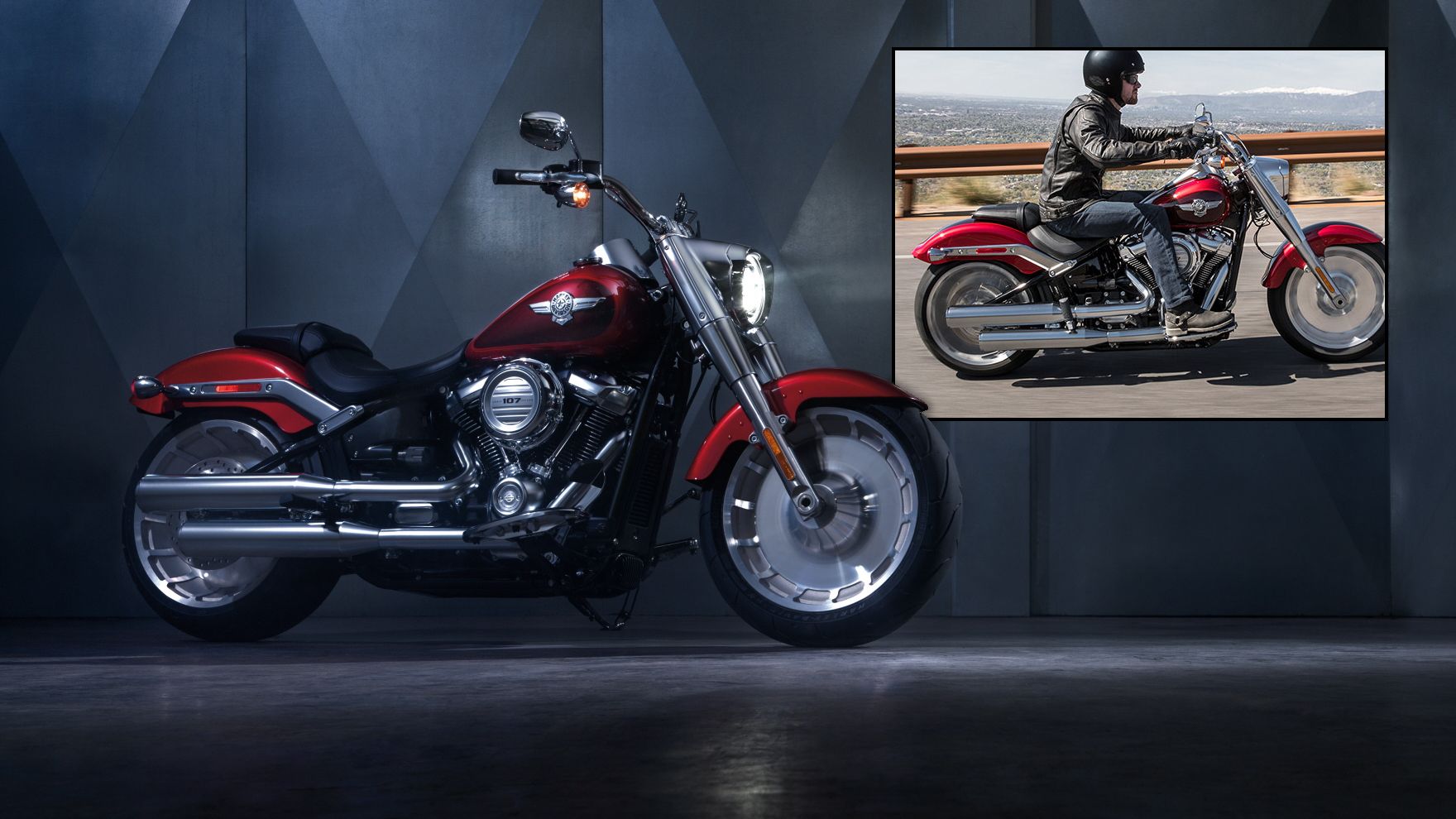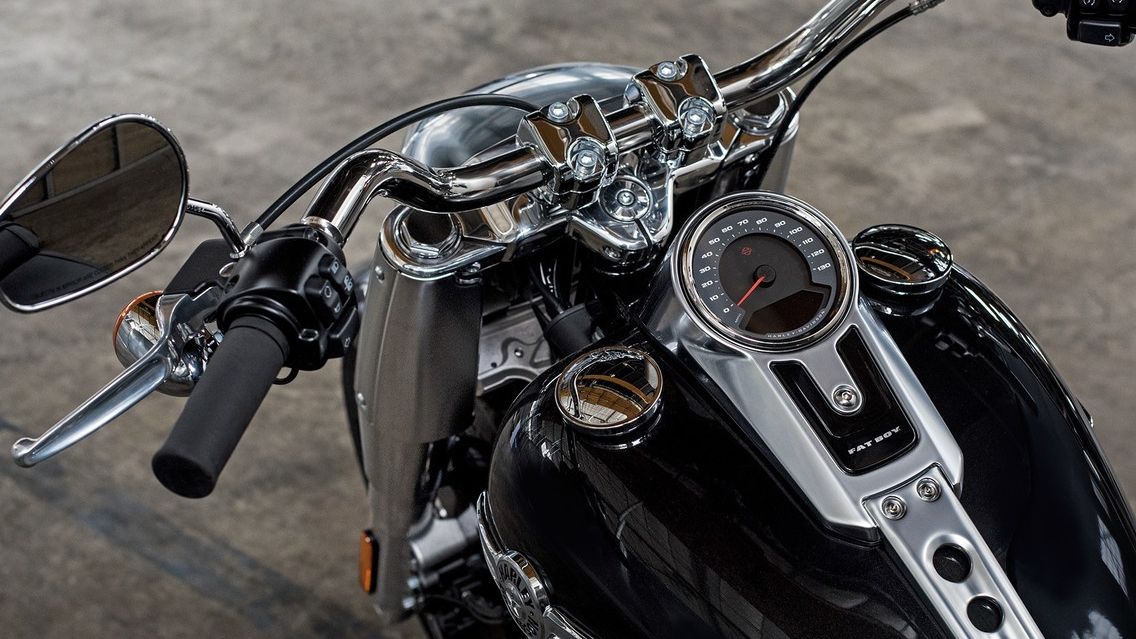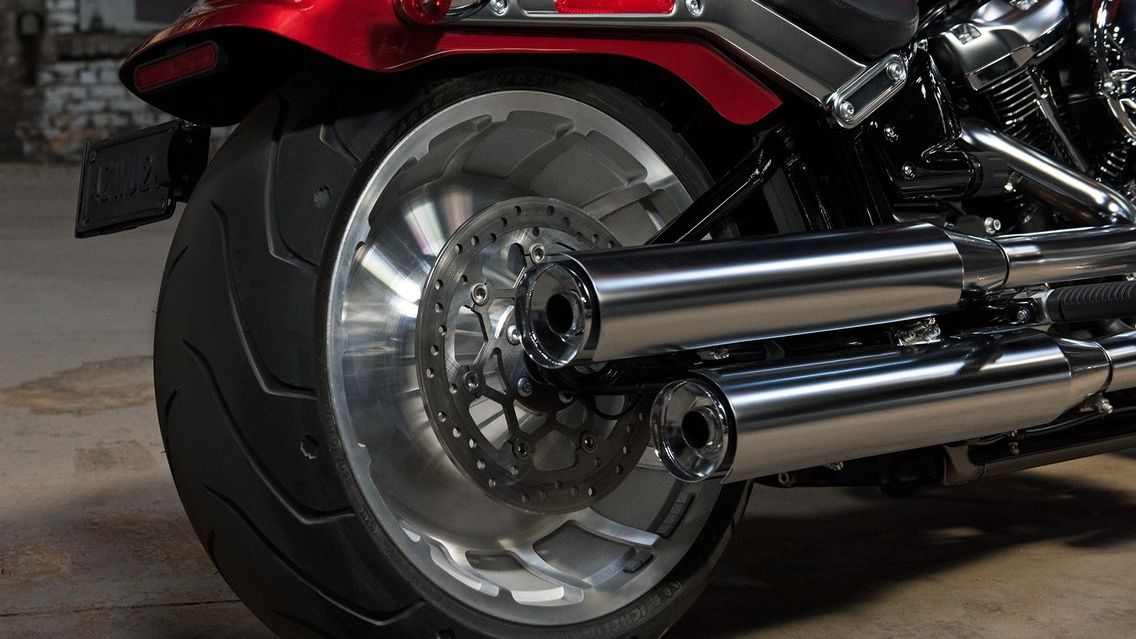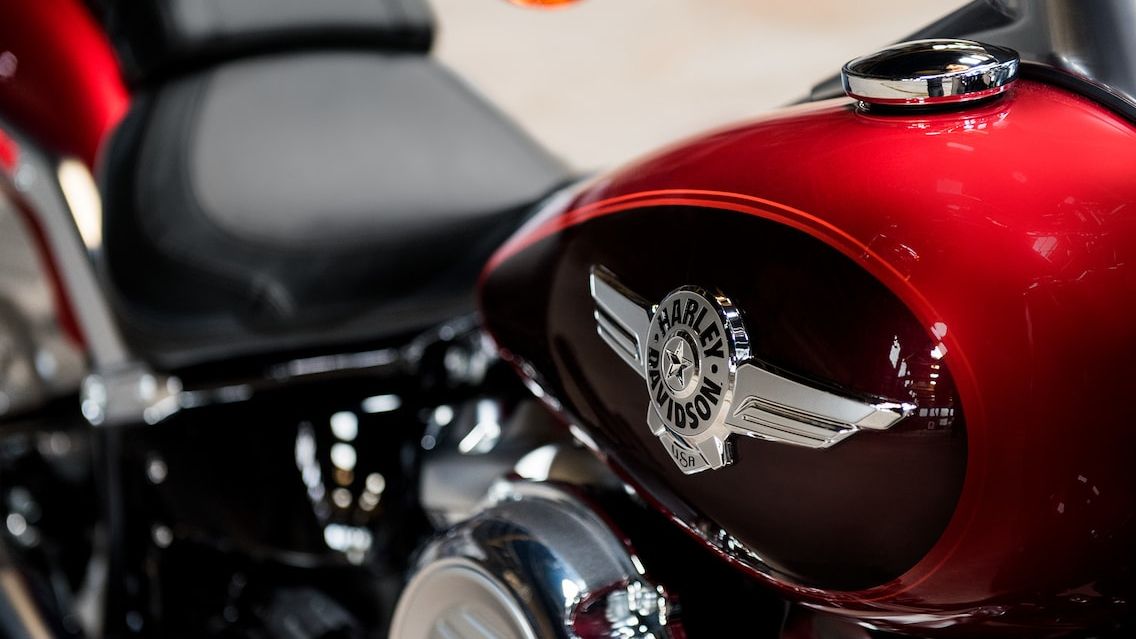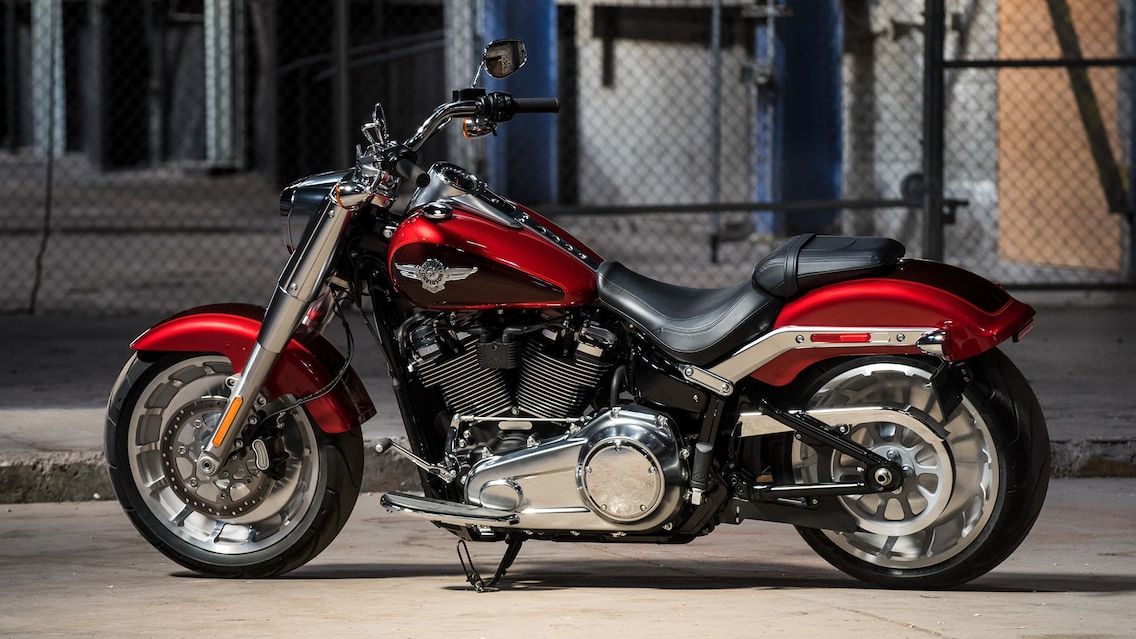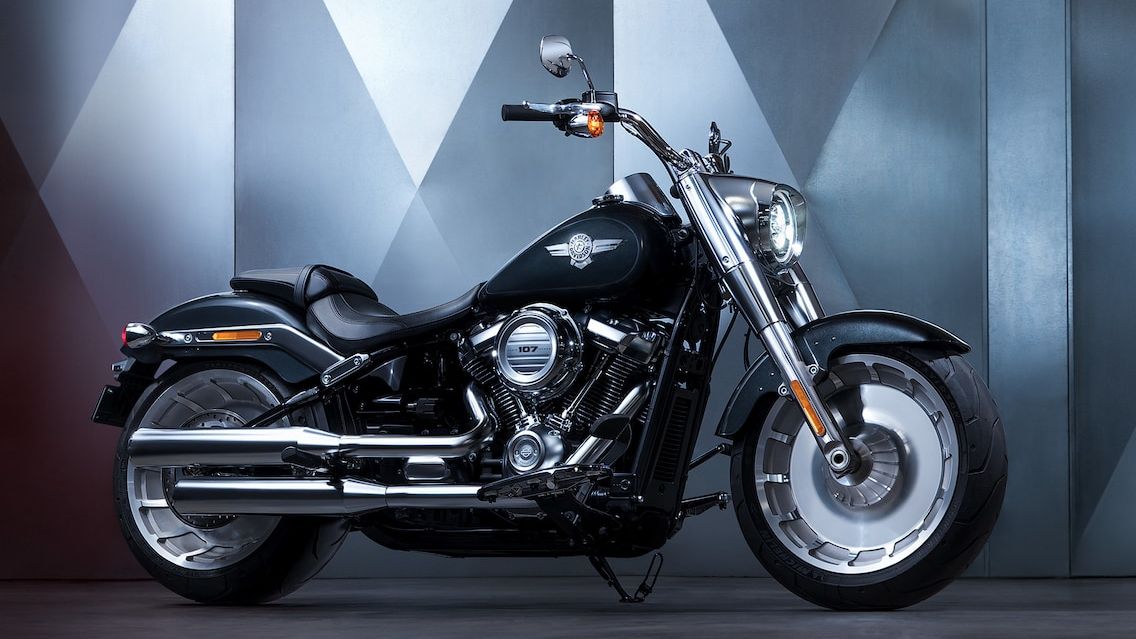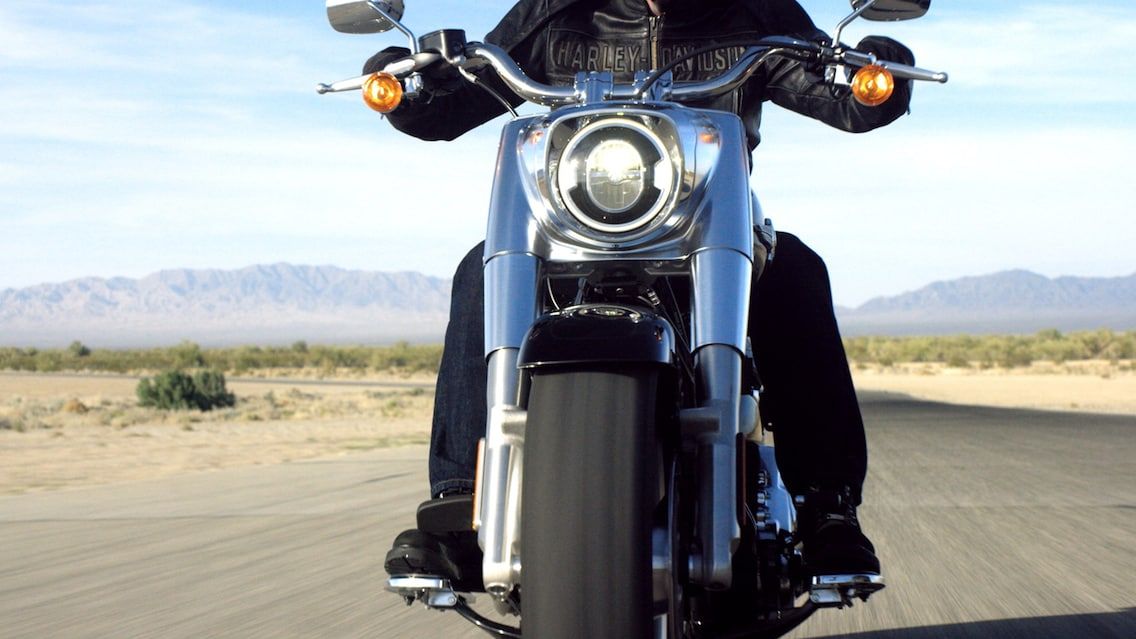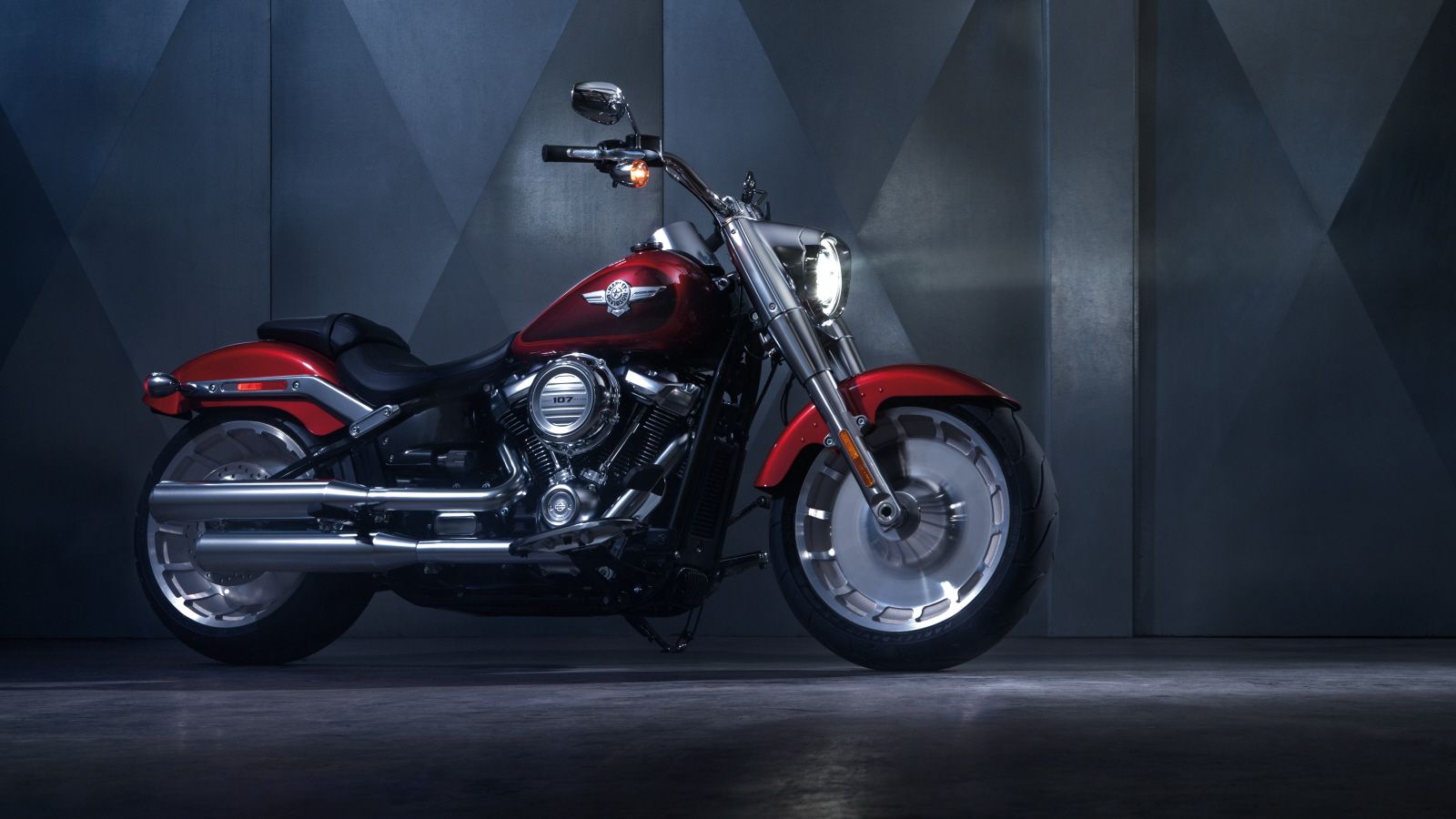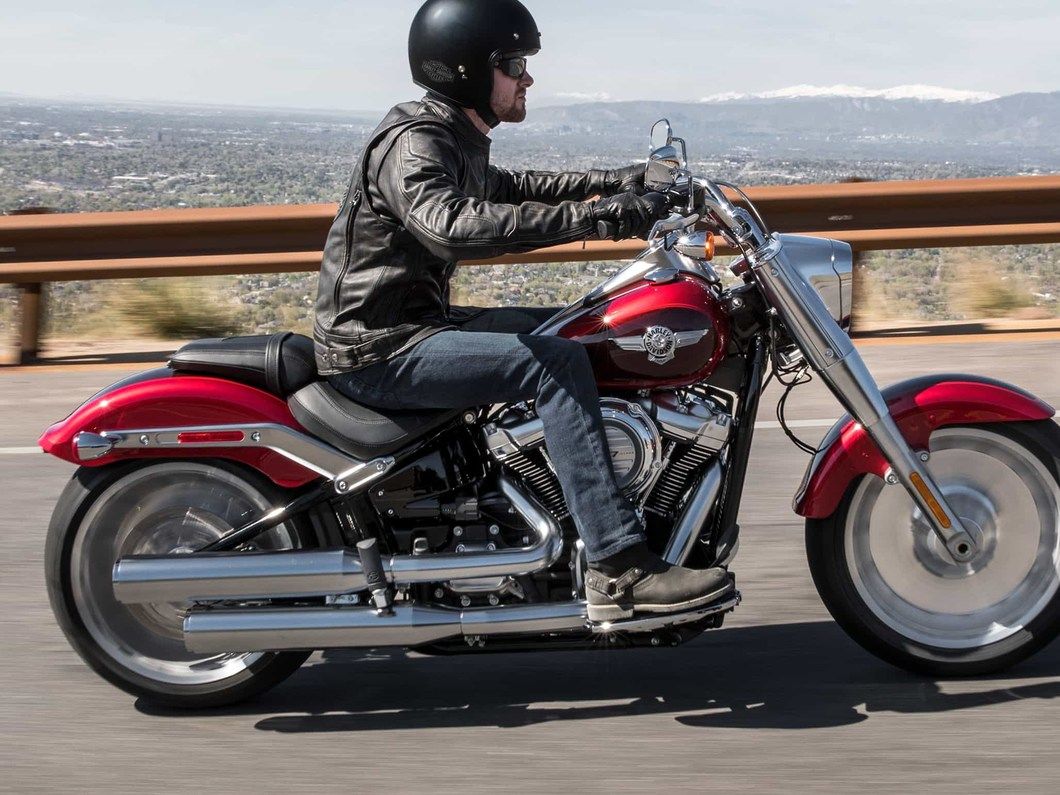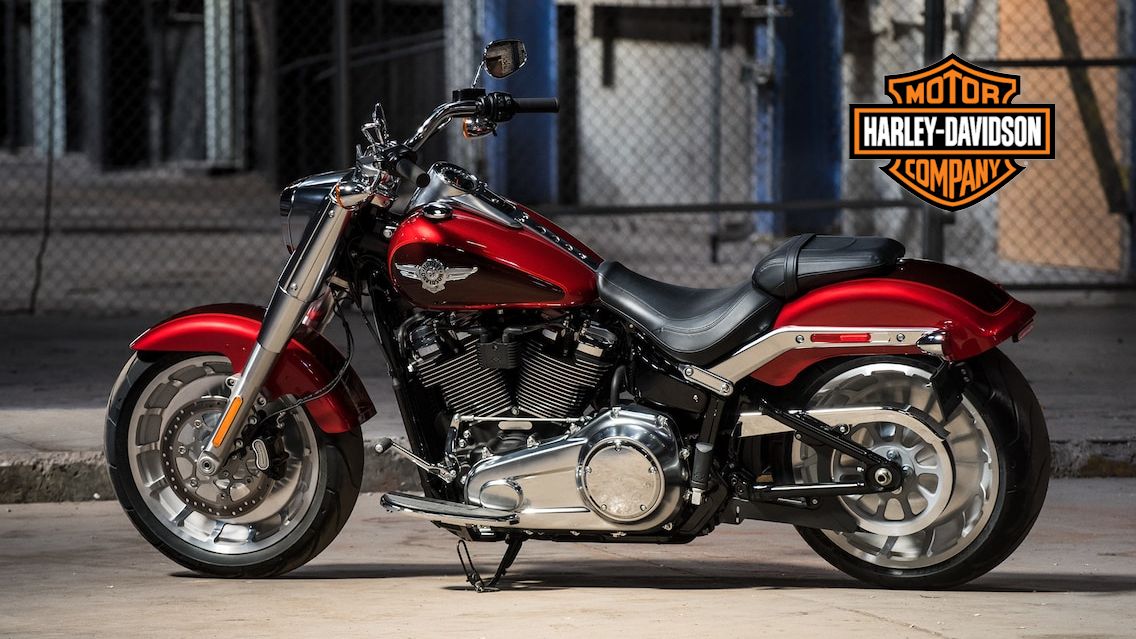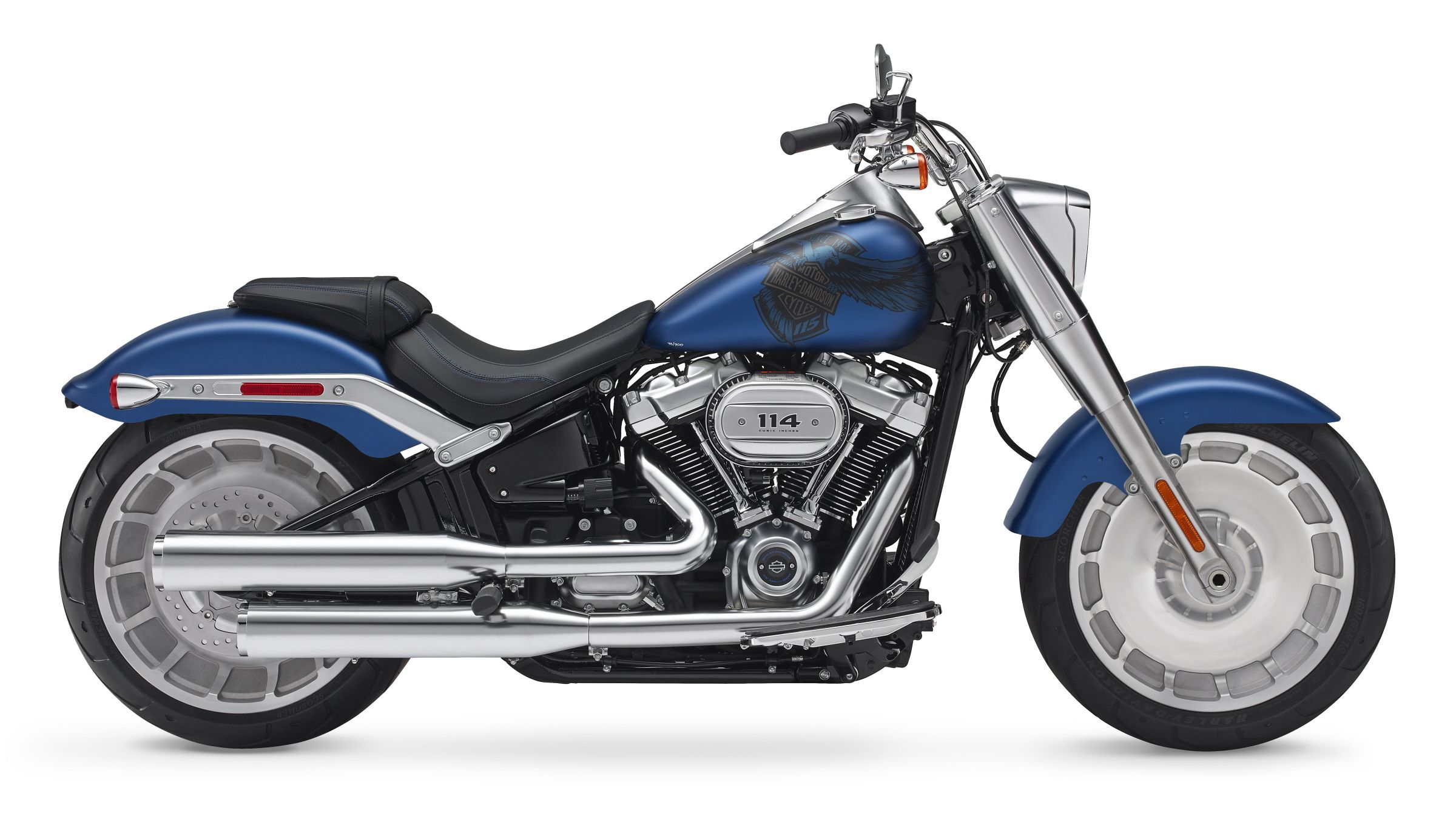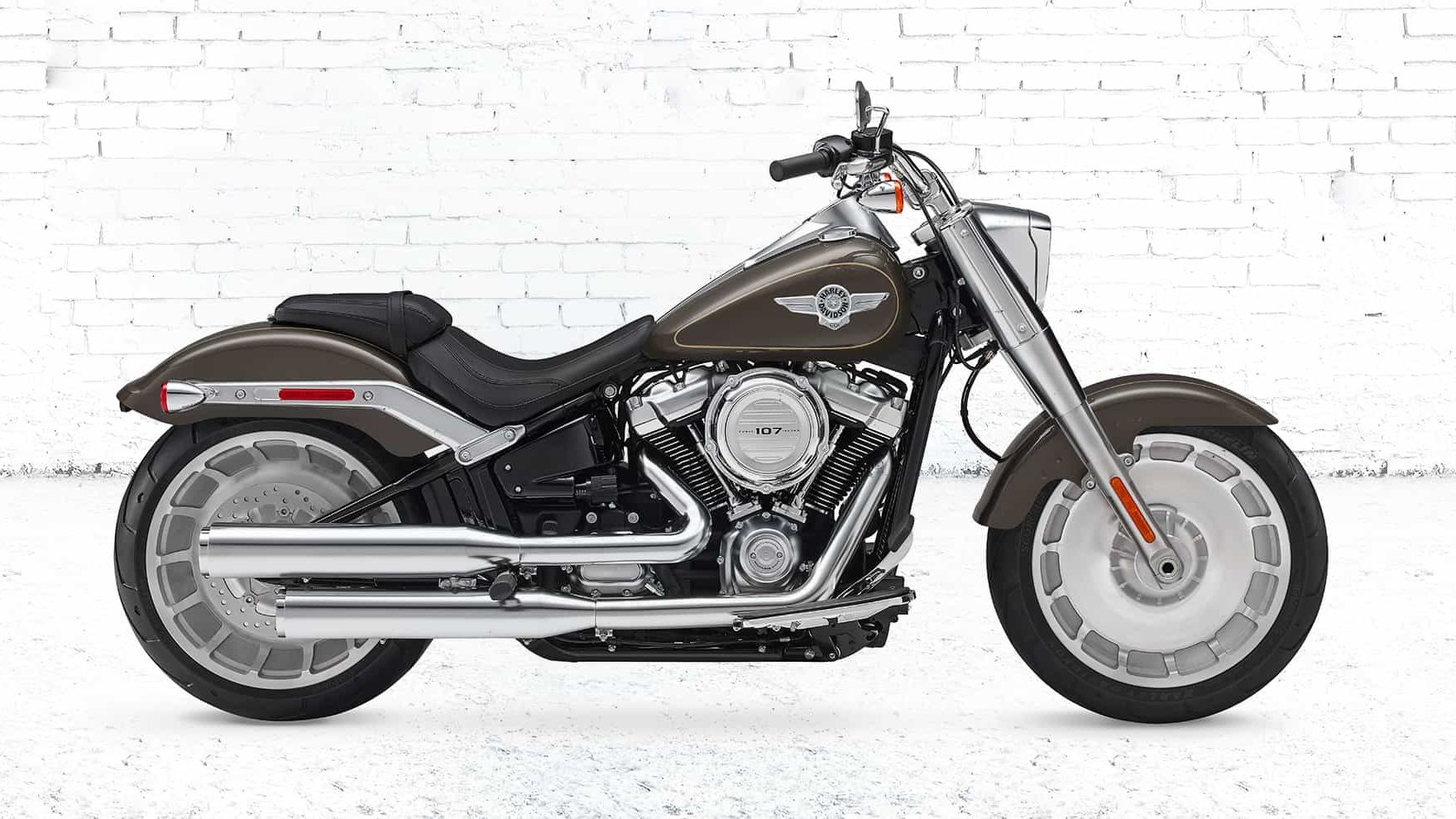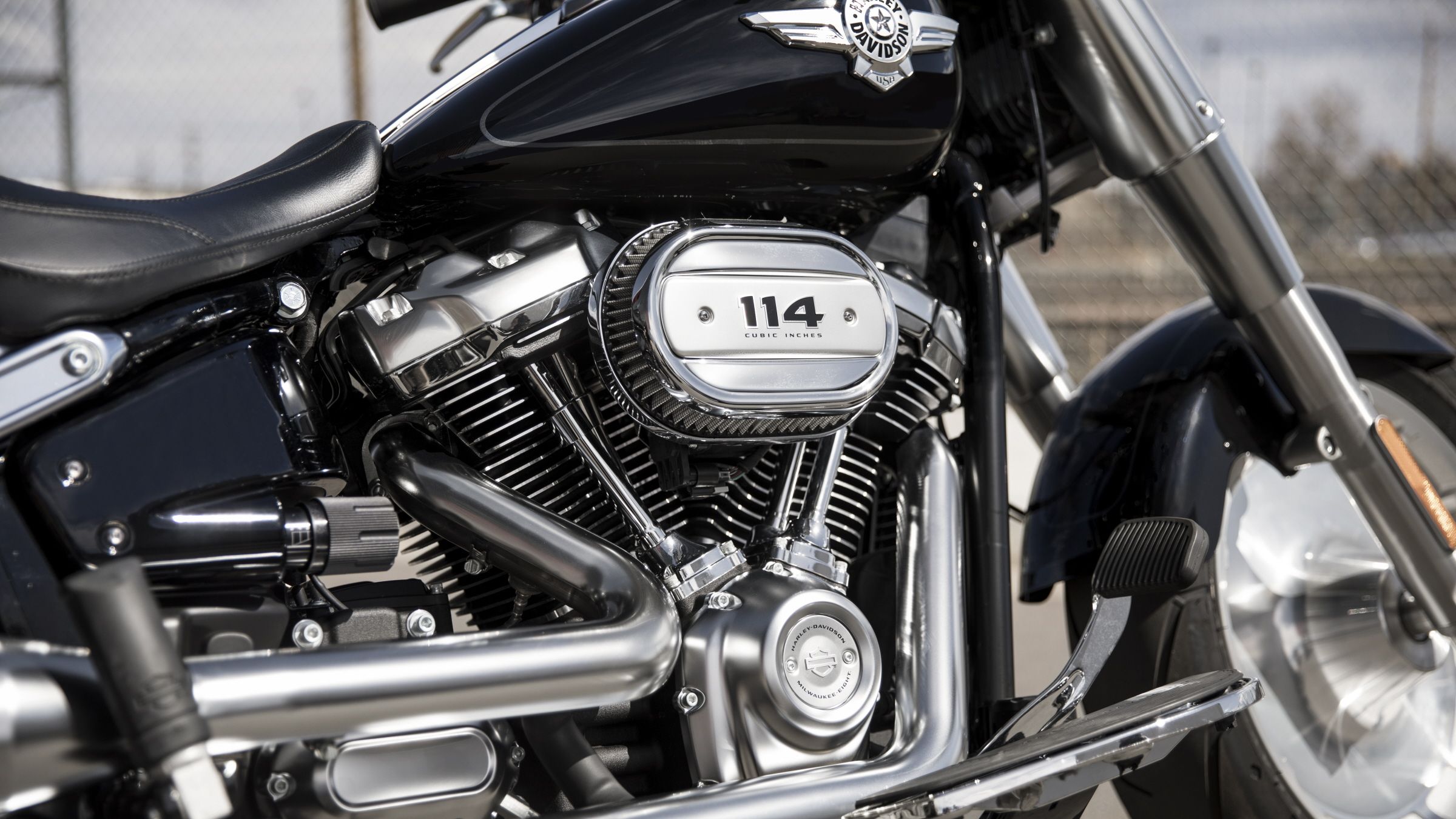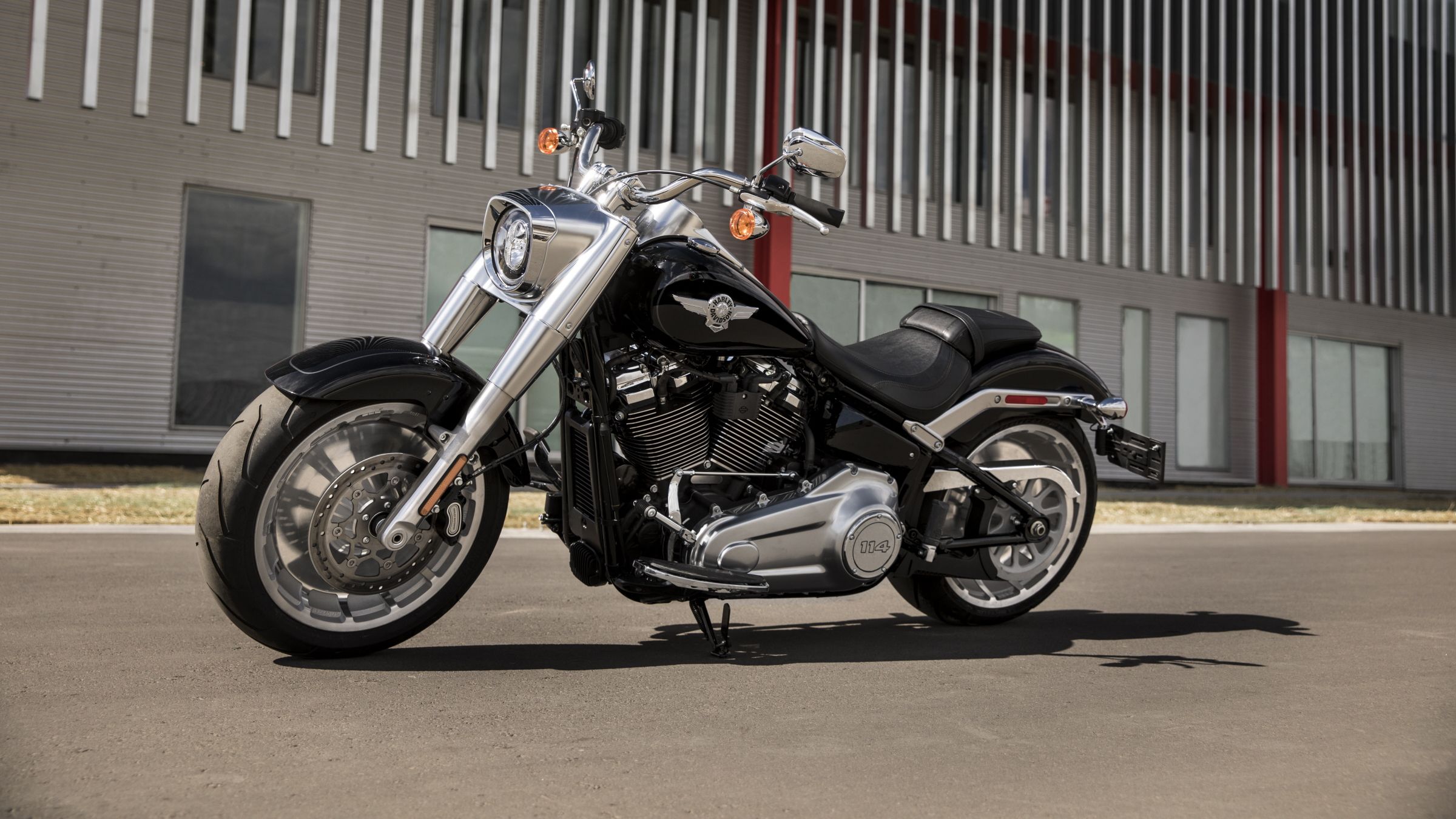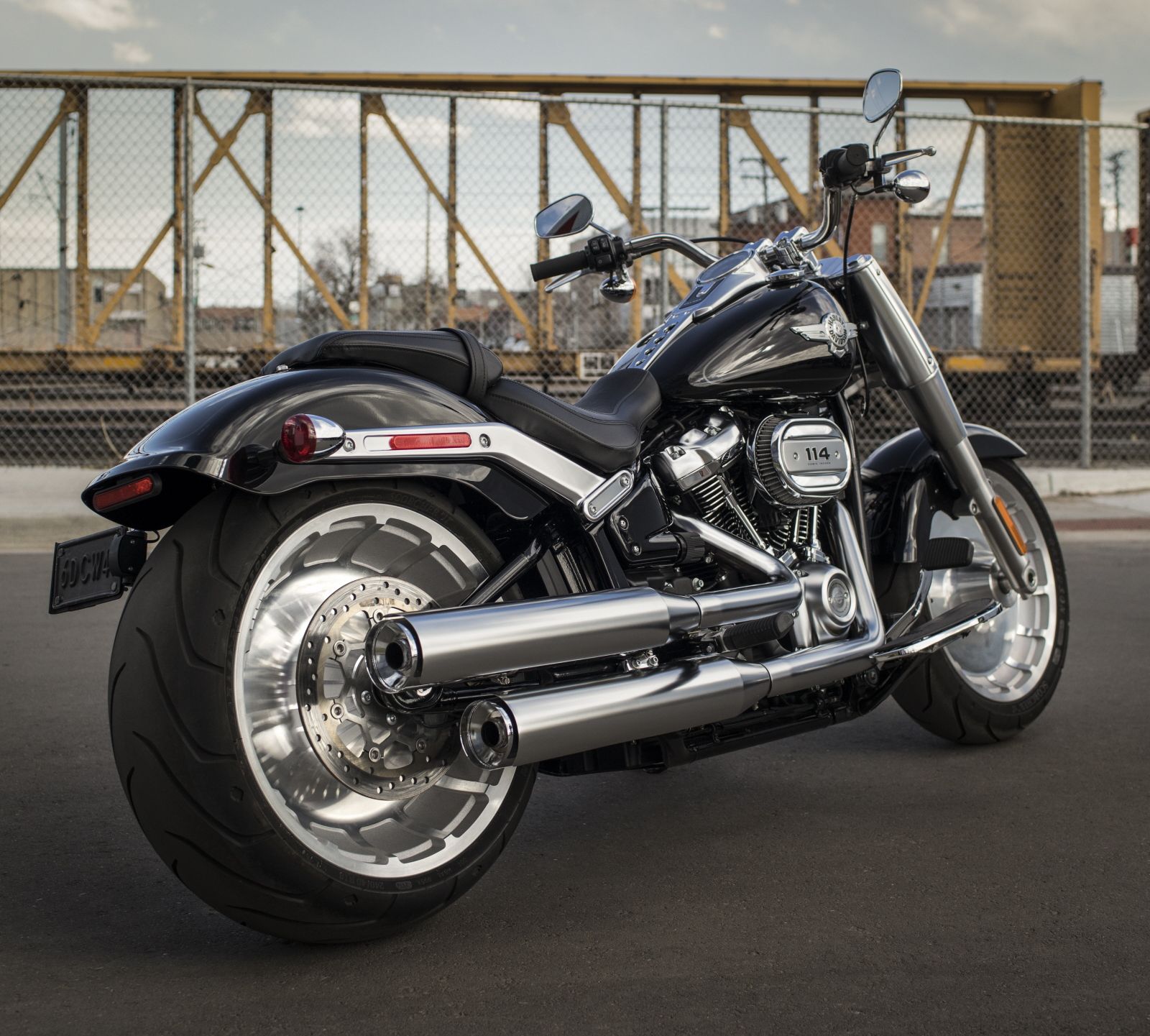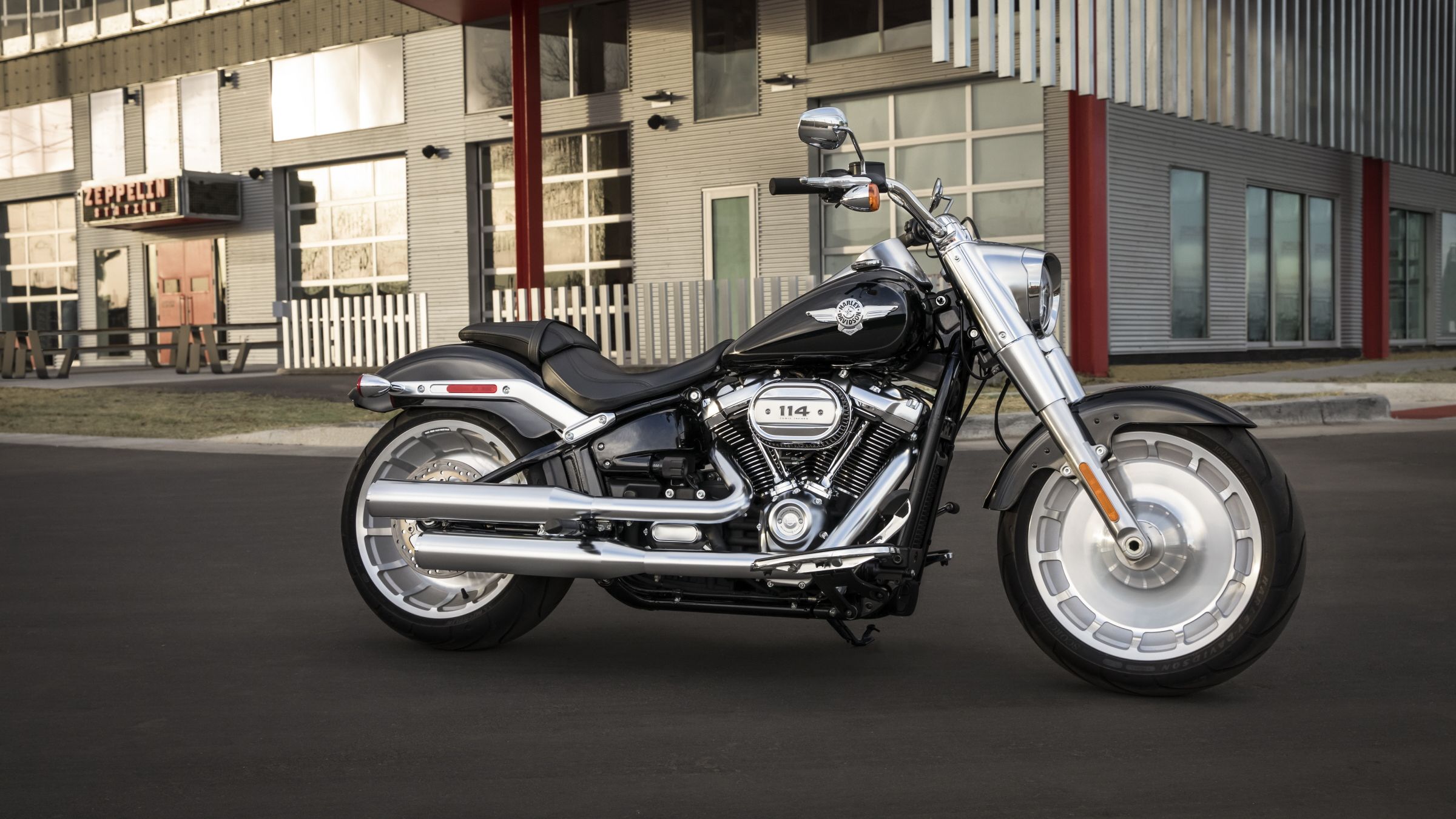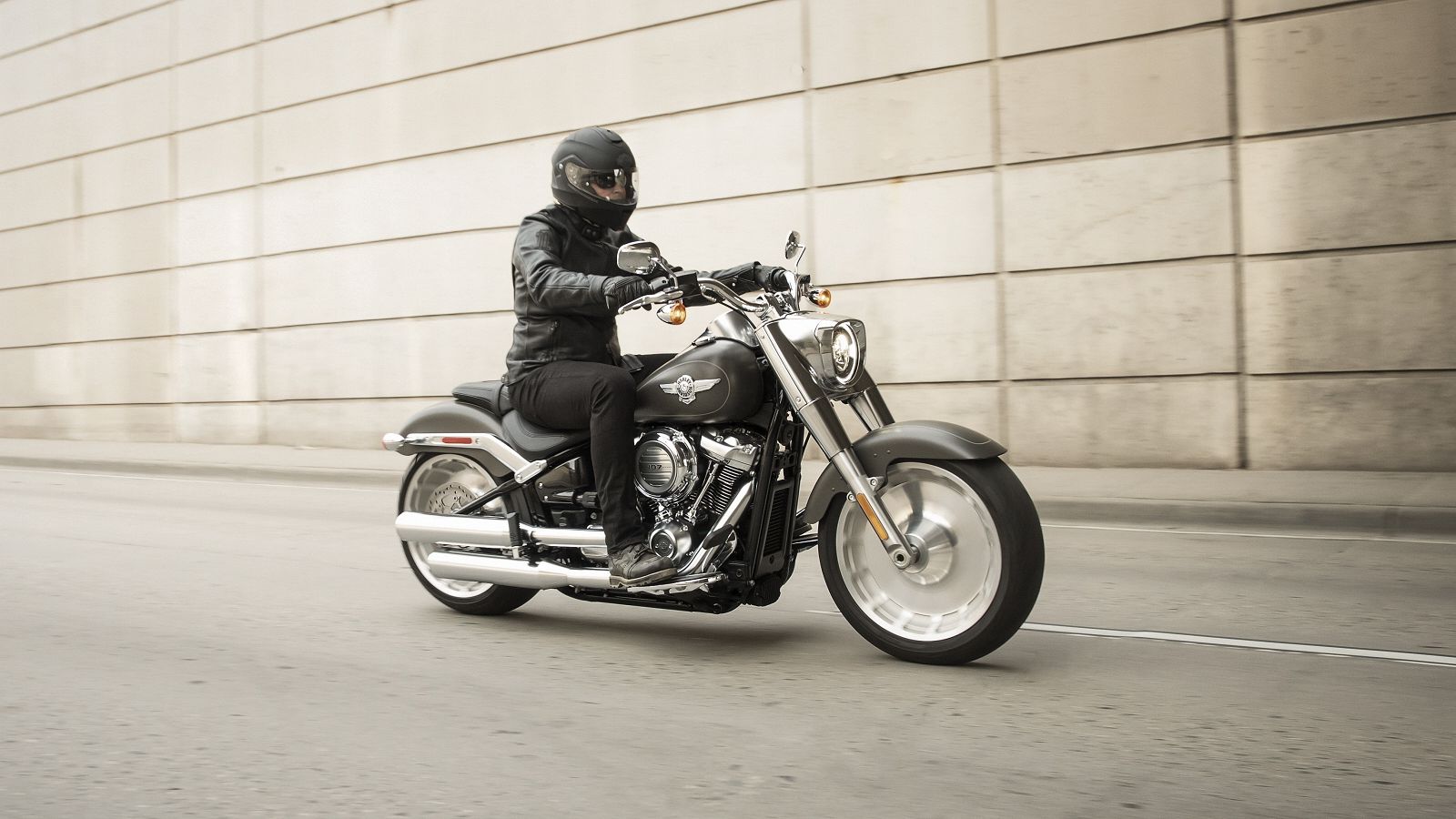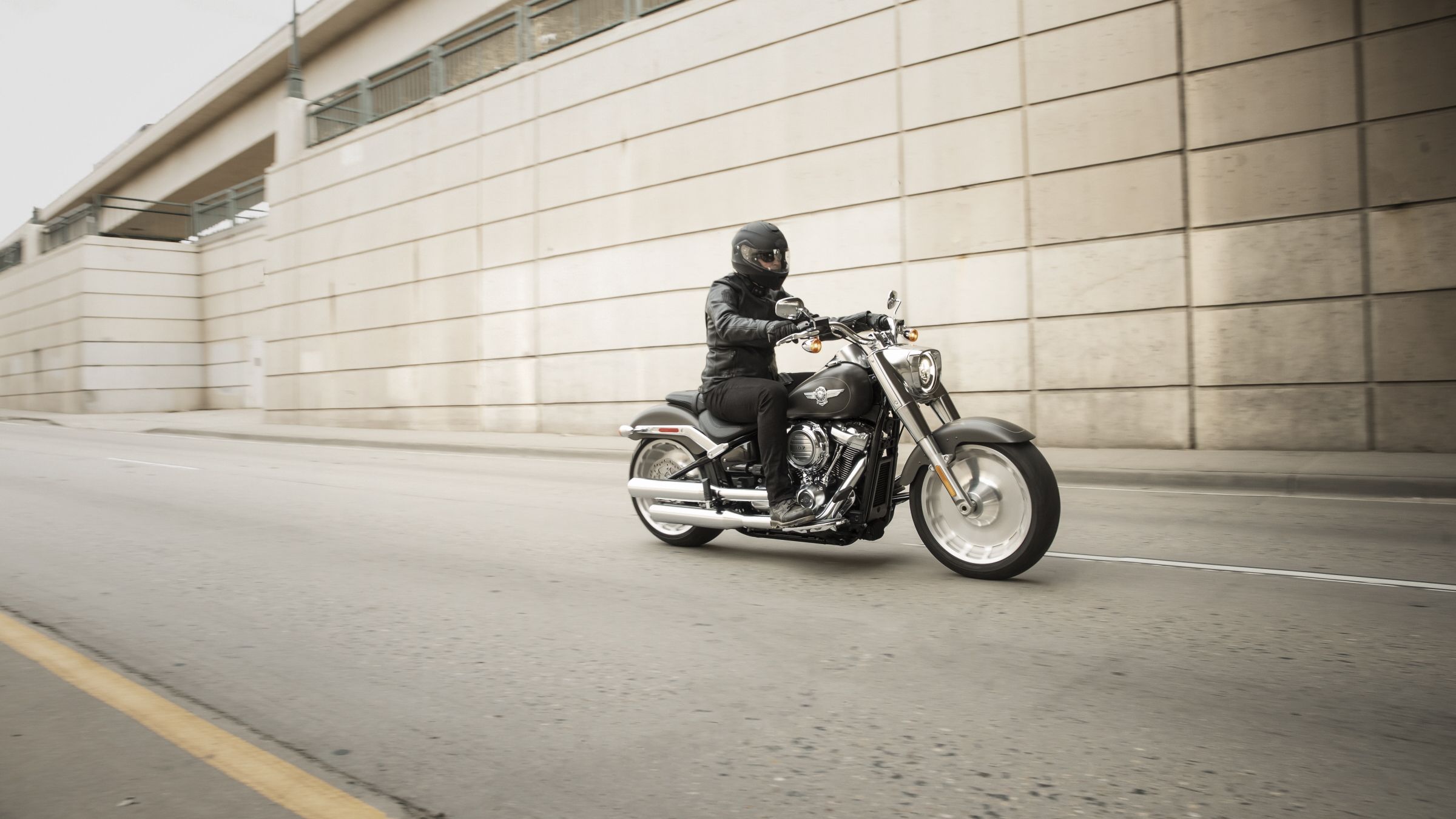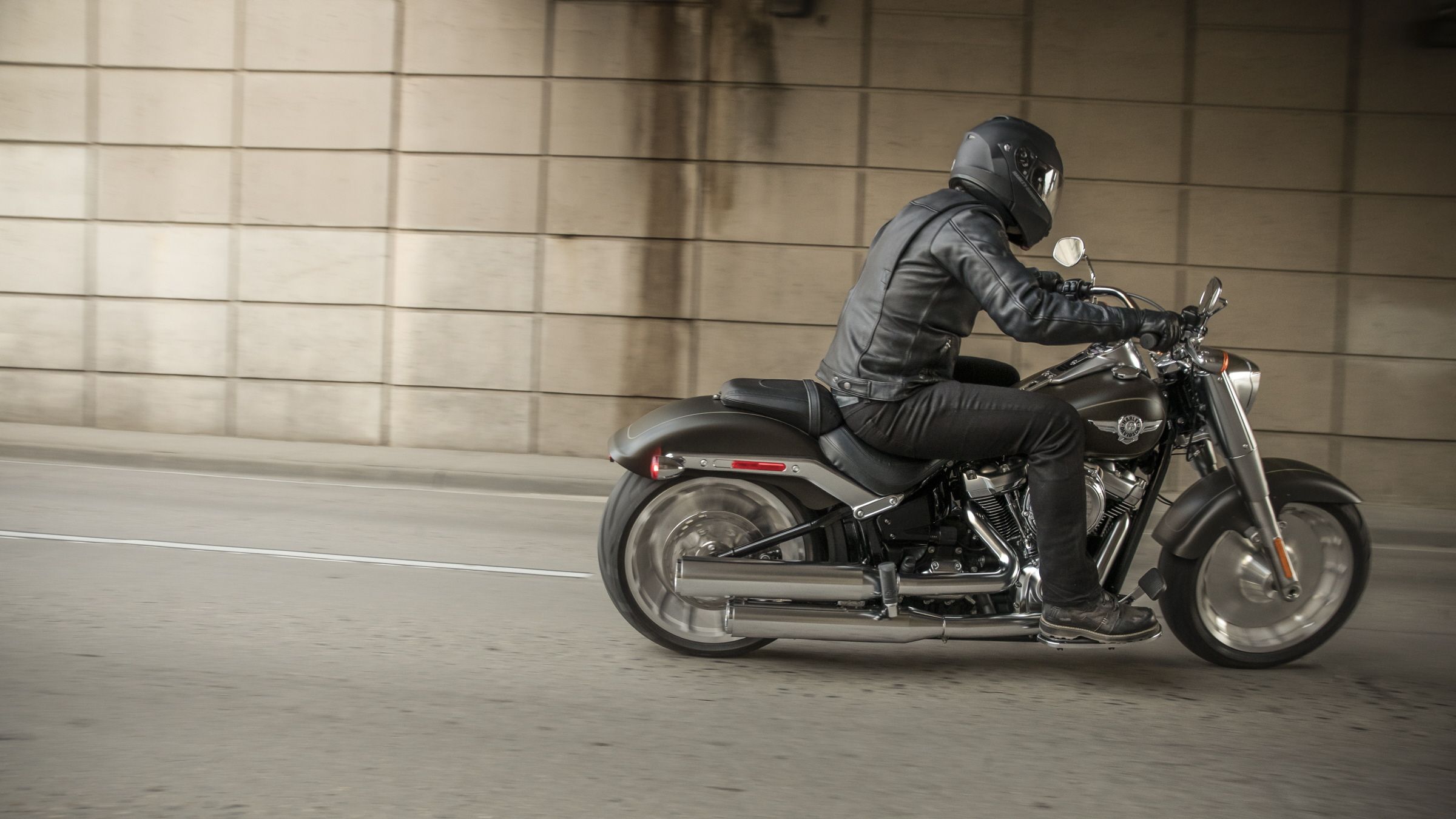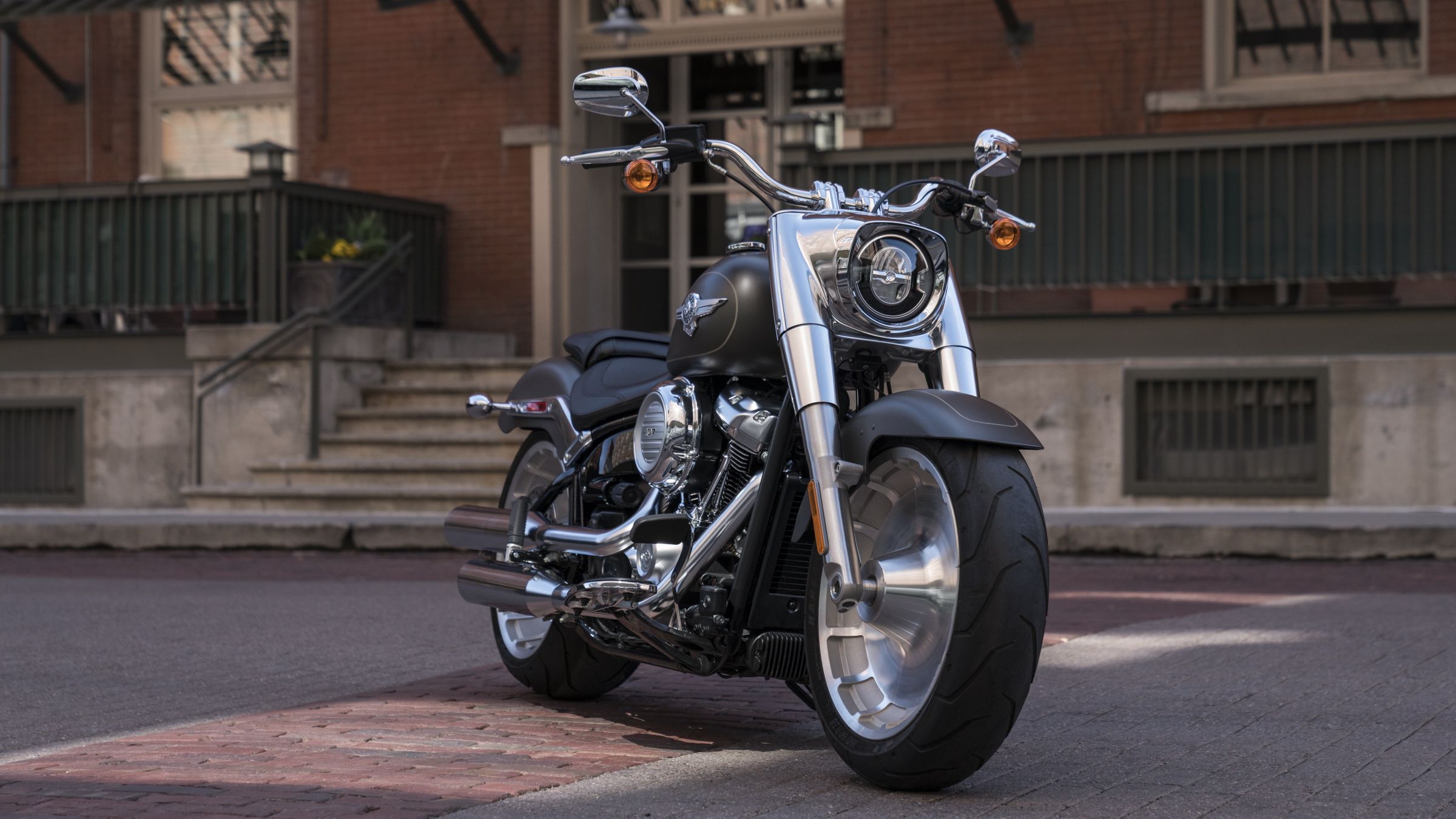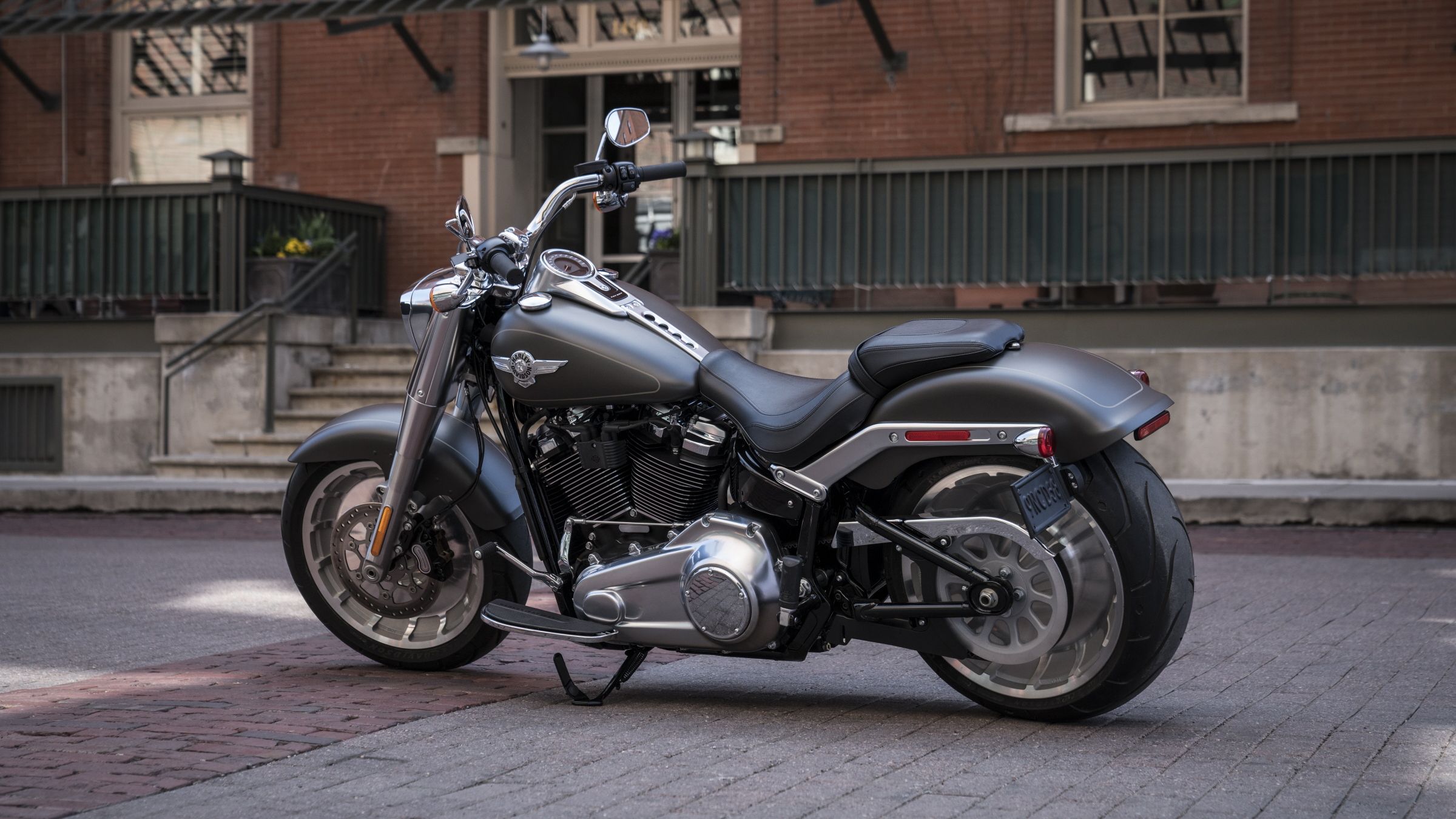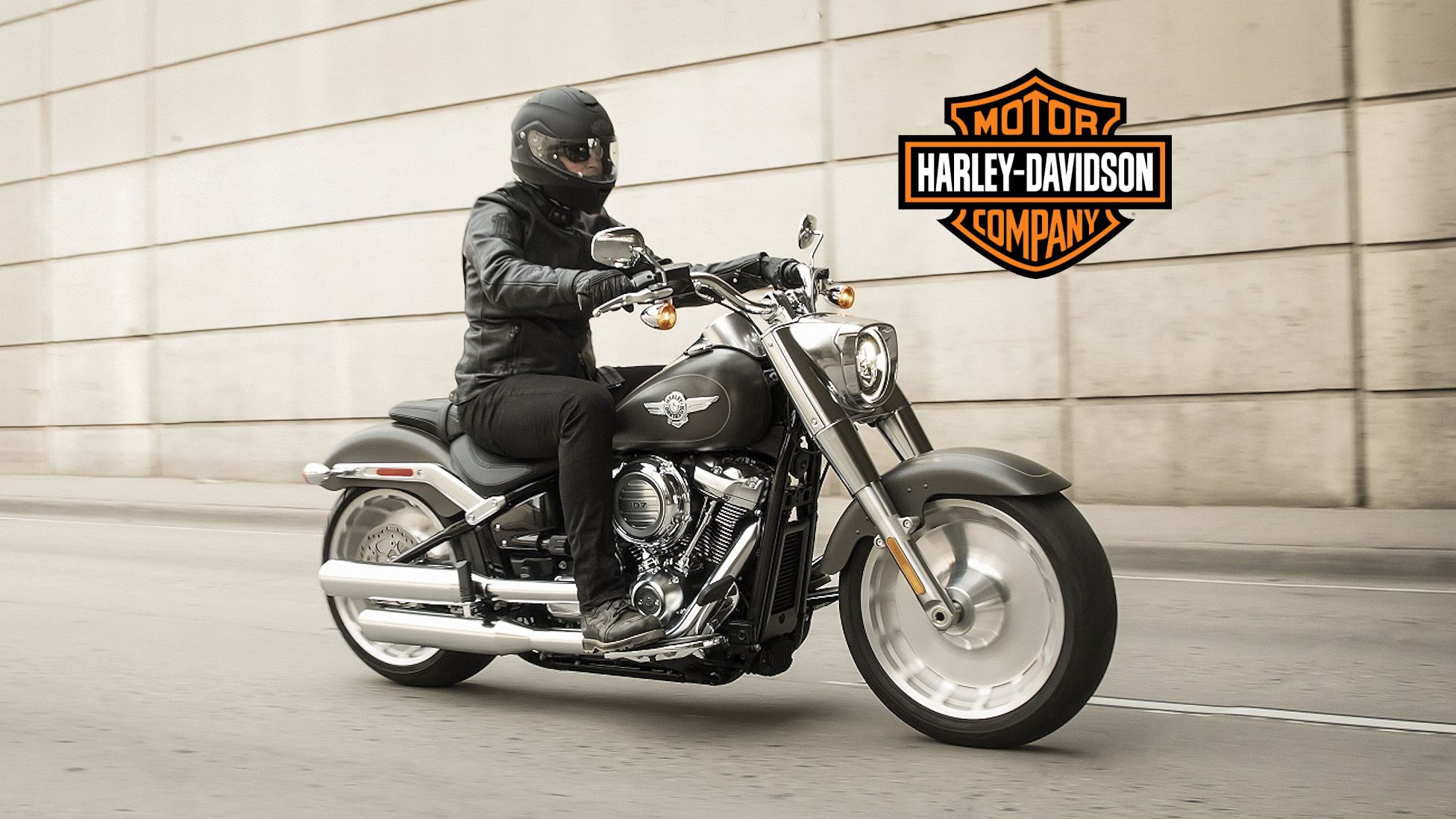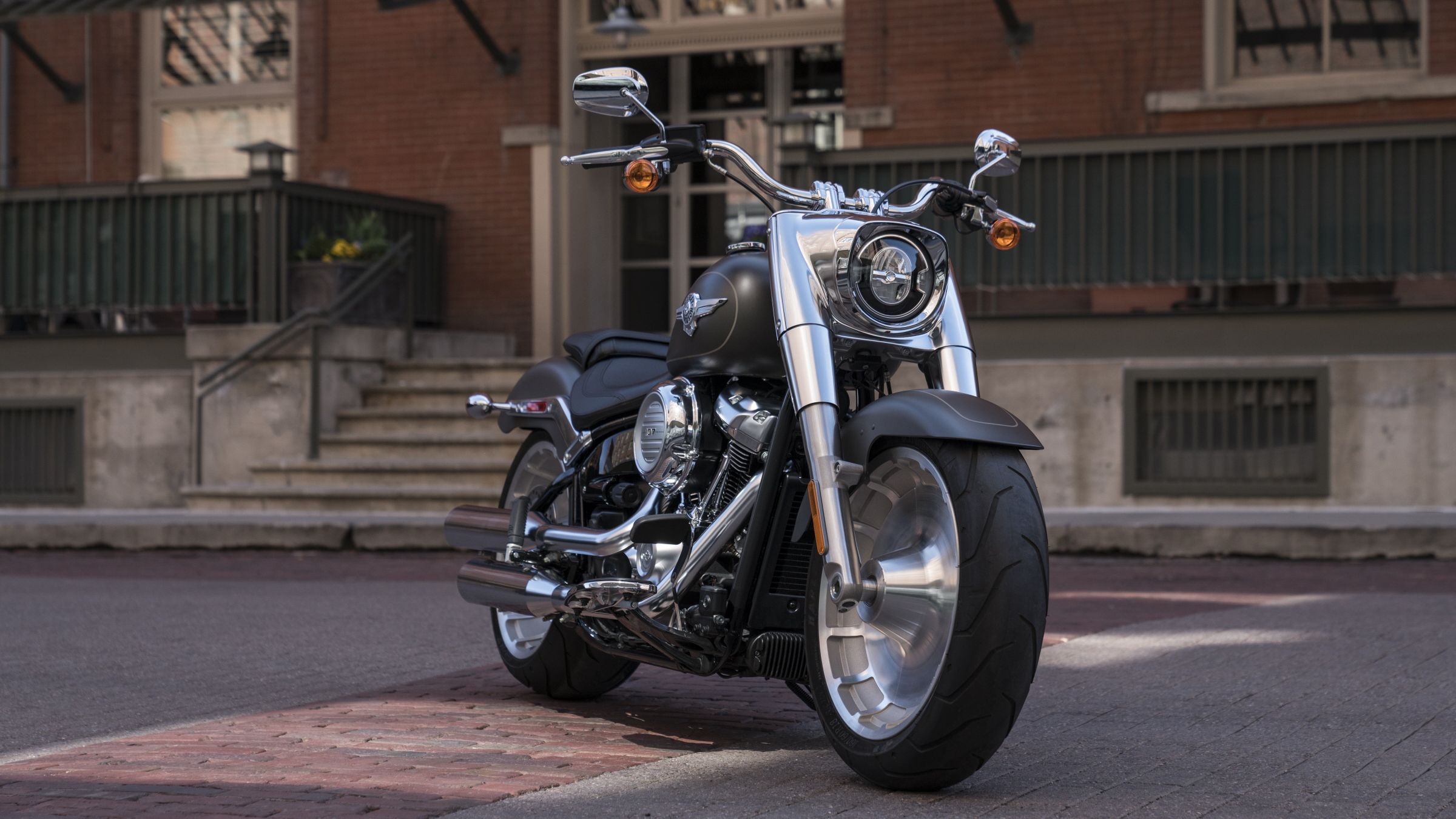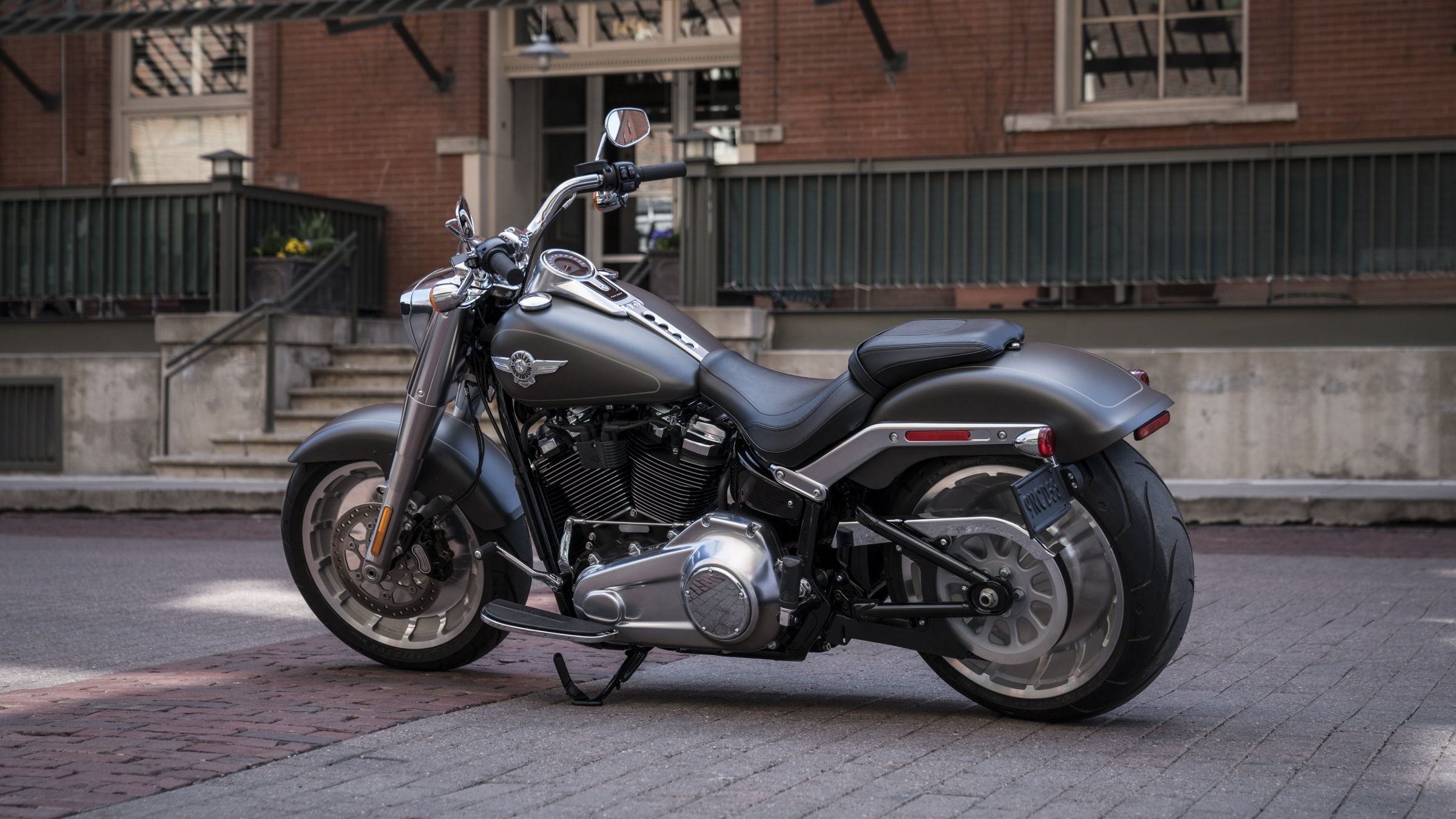Harley-Davidson's Fat Boy survived the Great Purge of 2017 that saw so many models eliminated from the Softail and Dyna lineups as the former absorbed the latter. The FLSTF joins the rest of the all-new-in-2018 Softail range with a completely reworked frame and a choice between the 107-inch and 114-inch Milwaukee-Eight powerplant, though the 107 was dropped going into 2020. New design features add to the aesthetics and clearly mark these Fat Boys as members of the New Guard.
2018 - 2020 Harley-Davidson Fat Boy
- Make: Array
- Model: 2018 - 2020 Harley-Davidson Fat Boy
- Engine/Motor: Milwaukee-Eight 114
- [do not use] Vehicle Model: Array
Harley-Davidson Fat Boy Design
The Fat Boy has been around, at least as a concept, since 1988, but it really showed up on everyone's radar and earned a place in American pop culture when old Arney rode one in Terminator 2. Low, wide, and intimidating, ever have these been the hallmarks of the Fat Boy line, and it's still true of today's subjects. This bottom-heavy look is something of an illusion created by the visual weight of the 18-inch, solid-disc Lakester rims. Yeah, the machined cast-aluminum rims look cool, but if you've ever ridden one you'll already know just how much windage they add, and how keenly every crosswind gust and pressure wave from larger traffic is felt.
The front fender is pared down just a skosh, a fact that does nothing to diminish the massy visage, and the front forks come with the classic beercan skirts to cover the swept area of the inner fork tubes. At the tripletree, the factory merged the old with the new in the design of the headlight nacelle. While the LED headlight cluster and DRL ring are round like we are accustomed to seeing, the housing itself is squared off on top, and y'all can go ahead and pencil me in as not a fan.
Though beefy, the front is is really clean. The bars are low and wide with short mirror stems, and since all the instrumentation is in the tank-mount console, the handlebar riser area is clean and wide open. From the clock to the butt bucket, the fall of the flylines mimics the old hardtail geometry with a 26.6-inch saddle height that cradles your fifth point of contact with an easy shot from hip to ground when it comes time to deploy the training wheels.
A relatively wide pillion pad tapers off Mustang-style over the bobbed rear fender, and while it does look cool, it's really more of a courtesy pad than something to be used for significant periods of time. Out back, the rear fender comes heavily bobbed with an LED lightbar tucked up under the brow of the fender for an ultra-clean rear end. The side-mount plateholder on the left side and standoff turn signals do little to diminish that clean panache. While there are still a handful of classic chrome parts to be found, Harley used “satin chrome” liberally throughout the design for a nice change from the same-old same-old, and I'm digging it.
Harley-Davidson Fat Boy Chassis
As always with a Softail model like the Fat Boy, it's the frame geometry and clever faux-rigid swingarm that makes the look work-rigid swingarm that makes the look work}}. The factory completely reworked the frame in the largest update ever bestowed on this family, and not only is it stiffer in all the right places, it's also lighter having left 50-percent of its frame members on the design-room floor.
It's fair to say that the Softail has never had a reputation for great comfort or maneuverability, but the times, they are a changin'. The new frame is built to deliver in the areas where its predecessor fell short with support from its hang-on equipment that further the cause. H-D still doesn't get into the whole “adjustable fork” thing, but it does grace the front end with a racing-style cartridge fork and follows up with a hidden monoshock that comes with an easily-accessible, hand-adjustable preload feature. Old school Softail fans will rejoice; no more laying on the ground and/or groping blindly for the shocks with a spanner.
The steering head is kicked out there with 30 degrees of rake that gives the Fat Boy 4.1 inches of trail along with great stability and tracking. H-D saves on the brakes with only a single disc up front. I know this is partly to leave an unobstructed view of the solid front disc, at least on the pretty side of the bike, but at 699 pounds wet, I'd rather have that extra stopping power, me. Good news is, the standard ABS feature will allow you to safely wring every ounce of stopping power out of that single front anchor.
|
Frame: |
Mild steel, tubular frame; rectangular section backbone; stamped, cast, and forged junctions; MIG welded; aluminum forged fender supports |
|
Swingarm: |
Mild steel, tubular sections, stamped x-member, forged axle junctions; MIG welded; removable belt spacer |
|
Front Forks: |
Dual Bending Valve 49 mm telescopic with aluminum fork triple clamps; dual rate spring; “beer can” covers |
|
Rear Shocks: |
Hidden, free piston, coil-over monoshock; 43 mm stroke; toolless hydraulic preload adjustment |
|
Suspension Travel, Front/Rear: |
5.1 in. (130 mm)/3.4 in. (86 mm) |
|
Rake (steering head): |
30° |
|
Fork Angle: |
32° |
|
Trail: |
4.1 in. (104 mm) |
|
Lean Angle (per J1168) Right/Left: |
25.6°/25.6° |
|
Wheels: |
Machined, Lakester Cast Aluminum |
|
Wheel, Front: |
18 in. x 4.5 in. (457 mm x 114 mm) |
|
Wheel, Rear: |
18 in. x 8 in. (457 mm x 203 mm) |
|
Tires: |
Michelin® Scorcher® “11” |
|
Tire, Front: |
160/60R18,70V,BW |
|
Tire, Rear: |
240/40R18,79V,BW |
|
Brakes, Front: |
11.8 in. x .2 in. (300 mm x 5.1 mm) silver, Split 7-spoke floating rotor, 4-piston fixed caliper |
|
Brakes, Rear: |
11.5 in. x .23 in. (292 mm x 5.8 mm) silver, Split 7-spoke floating rotor, 2-piston floating caliper |
|
Anti-Lock Braking System: |
Standard |
Harley-Davidson Fat Boy Drivetrain
The Fatboy came with a choice between the 107 cubic-inch, air-cooled Milwaukee-Eight that cranks out a generous 109 pound-feet of grunt, or the 114 cubic-inch version that brings 119 pounds o' grunt to the table. The 107 wasn't carried forward to 2020, no surprise there. Why get a 107 when you can get a 114? You can count on 47 mpg from whichever plant you choose. Unlike the frame, the engine has seen the light of day before and has been very well received. Relatively smooth and quiet, the Mil-8 engine runs with a balance shaft in the engine that tames the vibration significantly, perhaps too much according to the purists.
One thing the old guard will agree with is the shape of the right side of the engine. Gone is the ugly Twin-Cam bottom end for a return to more normal proportions in the nosecone area. Oh, and the 45-degree V-Twin persists, I reckon we're happy about that too. The engine still uses the old pushrod system, but instead of just a pair of poppets in each head the engine runs four for a total of eight, hence the ingeniously clever name.
|
Model: |
Fat Boy |
Fat Boy 114 |
|
Engine: |
Milwaukee-Eight® 107, Pushrod-operated, overhead valves with hydraulic, self-adjusting lifters; four valves per cylinder |
Milwaukee-Eight® 114, Pushrod-operated, overhead valves with hydraulic, self-adjusting lifters; four valves per cylinder |
|
Bore x Stroke: |
3.937 in. x 4.374 in. (100 mm x 111 mm) |
4.016 in. x 4.5 in. (102 mm x 114 mm) |
|
Displacement: |
107 cu. in. (1,746 cc) |
114 cu. in. (1,868 cc) |
|
Compression Ratio: |
10.0:1 |
10.5:1 |
|
Engine Torque (per J1349) (North America): |
109 ft. lb. @ 3,000 rpm (148 Nm @ 3,000 rpm) |
119 ft. lb. @ 3,000 rpm (161 Nm @ 3,000 rpm) |
|
Fuel System: |
Electronic Sequential Port Fuel Injection (ESPFI) |
Electronic Sequential Port Fuel Injection (ESPFI) |
|
Exhaust: |
2-into-2 staggered; catalyst in muffler |
2-into-2 staggered; catalyst in muffler |
|
Lubrication System: |
Pressurized, dry-sump with oil cooler |
Pressurized, dry-sump with oil cooler |
|
Primary Drive: |
Chain, 34/46 ratio |
Chain, 34/46 ratio |
|
Final Drive: |
Belt, 32/66 ratio |
Belt, 32/66 ratio |
|
Clutch: |
Mechanical, 10 plate wet, assist & conventional |
Mechanical, 10 plate wet, assist & conventional |
|
Transmission: |
6-Speed Cruise Drive® |
6-Speed Cruise Drive® |
|
Gear Ratios (overall)(U.S.): |
1st: 9.311, 2nd: 6.454, 3rd: 4.793, 4th: 3.882, 5th: 3.307, 6th: 2.79 |
1st: 9.311, 2nd: 6.454, 3rd: 4.793, 4th: 3.882, 5th: 3.307, 6th: 2.79 |
Harley-Davidson Fat Boy Pricing
As ever, the Motor Company follows a tiered price structure based on color and engine selection. At the bottom of the scale, the 2020 Fat Boy 114 will set you back $20,599 in Vivid Black. Adding colors and two-tones will run you as high as $21,749.
|
Model: |
Fat Boy |
Fat Boy 114 |
|
Model: |
24 months (unlimited mileage) |
24 months (unlimited mileage) |
|
Model ID:}} |
FLFB |
FLFBS |
|
Fat Boy |
ABS Option, Security System Option |
ABS Option, Security System Option |
|
Fat Boy 114 |
||
|
└ 2018: |
Vivid Black, Black Tempest, Industrial Gray, Bonneville Salt Pearl; Two-Tone: Wicked Red/Twisted Cherry |
Vivid Black, Black Tempest, Industrial Gray, Bonneville Salt Pearl; Two-Tone: Wicked Red/Twisted Cherry; Anniversary: Legend Blue Denim, Legend Blue/Vivid Black |
|
└ 2019: |
Vivid Black, Industrial Gray Denim, Wicked Red, Industrial Gray Denim/Black Denim |
Vivid Black, Industrial Gray Denim, Wicked Red, Midnight Blue, Rawhide, Industrial Gray Denim/Black Denim, Blue Max, Scorched Orange/Black Denim |
|
└ 2020: |
N/A |
Vivid Black, Midnight Blue, Barracuda Silver, Spruce, River Rock Gray/Vivid Black, Barracuda Silver Denim/Black Denim, Stiletto Red, Zephyr Blue/Black Sunglo, Vivid Black Anniversary |
|
Warranty: |
||
|
└ 2018: |
Vivid Black: $18,999, Color: $19,399, Two-Tone: $19,749 |
Vivid Black: $20,299, Color: $20,699, Two-Tone: $21,049, Anniversary: $21,199 |
|
└ 2019: |
Vivid Black: $19,049, Color: $19,449, Two-Tone: $19,799 |
Vivid Black: $20,449, Color: $20,849, Two-Tone: $21,199, Custom Color: $21,399, Two-Tone Custom Color: $21,599 |
|
└ 2020: |
N/A |
Vivid Black: $$20,599, Color: $20,999, Two-Tone: $21,349, Custom Color: $21,549, Two-Tone Custom Color: $21,749 |
Harley-Davidson Fat Boy Competitors
Ya know, I took a look at the Boulevard M109R Blacked Out Special from Suzuki, but I just wasn't feeling it. Why should I when I have another bona fide American legend to draw upon -- Indian Motorcycle -- and its Indian Chief?
Indian Motorcycle Indian Chief
Like the Fat Boy, the Chief absolutely oozes with retro appeal, just in different ways than the Fat Boy. The classic full front fender sports the timeless Indian Head figure below fork skirts and round nacelle. A fuel-tank console carries the clock, but unlike the Fat Boy, you'll have to hit the accessories catalog for a P-pad before you think about taking a passenger.
The Chief rolls with stock ABS and cartridge-type forks, but offers nothing beyond the same vanilla fare we get from Harley. Power from the 111 cubic-inch plant is about what you'd expect from a big V-twin with 119 pound-feet of torque on tap, equal to the Mil-8 114, but a skosh higher than the 107-inch plant. Honestly, anything over 100 is just vanity, right?
Pricing is comparable as well. The Chief rolls for $18,499 in Steel Gray, a couple grand under the basic black Fat Boy 107, but Indian stops there with the color selection. While I like how Indian's paint department is developing, I gotta say I'm a little disappointed with the lack of choices here.
Read our full review of the Indian Motorcycle Indian Chief.
He Said
“I've always loved the Fat Boy, right from the get go, and I'm pleased the factory brought it forward into this new Age of the Softail. The Mil-8 engine is a sweet plant and Harley is finally getting onboard offering some traction control or power modes so maybe that will trickle down the lines.”
She Said
My wife and fellow motorcycle writer, Allyn Hinton, says, “I notice that the new Fat Boy seems easier to stand up, and maybe all the new Softails, too, but I really noticed it with the Fat Boy. The bike stands more upright on the kickstand, so it's just an easy tip up instead of a hoist. You feel the fat tires resisting the corners; not a bad thing, just noticeable. It's a cruiser, so nimble isn't the first adjective that comes to mind, anyway. The seat is very comfortable, so very plush; and you have to notice the lack of vibration. of vibration.}} Numbing vibration had always been a given on a Harley, but not anymore. I like it. Low seat height, butt-friendly saddle and a smooth, dare I say it? luxurious ride luxurious ride}}.”
Harley-Davidson Fat Boy Specifications
|
Model: |
Model: |
Fat Boy 114 |
|
Fat Boy 107 |
||
|
Engine: |
Milwaukee-Eight® 107, Pushrod-operated, overhead valves with hydraulic, self-adjusting lifters; four valves per cylinder |
Milwaukee-Eight® 114, Pushrod-operated, overhead valves with hydraulic, self-adjusting lifters; four valves per cylinder |
|
Bore x Stroke: |
3.937 in. x 4.374 in. (100 mm x 111 mm) |
4.016 in. x 4.5 in. (102 mm x 114 mm) |
|
Displacement: |
107 cu. in. (1,746 cc) |
114 cu. in. (1,868 cc) |
|
Compression Ratio: |
10.0:1 |
10.5:1 |
|
Engine Torque (per J1349) (North America): |
109 ft. lb. @ 3,000 rpm (148 Nm @ 3,000 rpm) |
119 ft. lb. @ 3,000 rpm (161 Nm @ 3,000 rpm) |
|
Fuel System: |
Electronic Sequential Port Fuel Injection (ESPFI) |
Electronic Sequential Port Fuel Injection (ESPFI) |
|
Air Cleaner: |
8.5 in. round, radial bolt cover with washable fiberglass filter media |
Ventilator intake with fiberglass media, washable exposed element with rain sock |
|
Exhaust: |
2-into-2 staggered; catalyst in muffler |
2-into-2 staggered; catalyst in muffler |
|
Lubrication System: |
Pressurized, dry-sump with oil cooler |
Pressurized, dry-sump with oil cooler |
|
Primary Drive: |
Chain, 34/46 ratio |
Chain, 34/46 ratio |
|
Final Drive: |
Belt, 32/66 ratio |
Belt, 32/66 ratio |
|
Clutch: |
Mechanical, 10 plate wet, assist & conventional |
Mechanical, 10 plate wet, assist & conventional |
|
Transmission: |
6-Speed Cruise Drive® |
6-Speed Cruise Drive® |
|
Gear Ratios (overall)(U.S.): |
1st: 9.311, 2nd: 6.454, 3rd: 4.793, 4th: 3.882, 5th: 3.307, 6th: 2.79 |
1st: 9.311, 2nd: 6.454, 3rd: 4.793, 4th: 3.882, 5th: 3.307, 6th: 2.79 |
|
Fat Boy 114 |
||
|
Frame: |
Mild steel, tubular frame; rectangular section backbone; stamped, cast, and forged junctions; MIG welded; aluminum forged fender supports |
Mild steel, tubular frame; rectangular section backbone; stamped, cast, and forged junctions; MIG welded; aluminum forged fender supports |
|
Swingarm: |
Mild steel, tubular sections, stamped x-member, forged axle junctions; MIG welded; removable belt spacer |
Mild steel, tubular sections, stamped x-member, forged axle junctions; MIG welded; removable belt spacer |
|
Front Forks: |
Dual Bending Valve 49 mm telescopic with aluminum fork triple clamps; dual rate spring; “beer can” covers |
Dual Bending Valve 49 mm telescopic with aluminum fork triple clamps; dual rate spring; “beer can” covers |
|
Rear Shocks: |
Hidden, free piston, coil-over monoshock; 43 mm stroke; toolless hydraulic preload adjustment |
Hidden, free piston, coil-over monoshock; 43 mm stroke; toolless hydraulic preload adjustment |
|
Suspension Travel, Front/Rear: |
5.1 in. (130 mm)/3.4 in. (86 mm) |
5.1 in. (130 mm)/3.4 in. (86 mm) |
|
Rake (steering head): |
30° |
30° |
|
Fork Angle: |
32° |
32° |
|
Trail: |
4.1 in. (104 mm) |
4.1 in. (104 mm) |
|
Lean Angle (per J1168) Right/Left: |
25.6°/25.6° |
25.6°/25.6° |
|
Wheels: |
Machined, Lakester Cast Aluminum |
Machined, Lakester Cast Aluminum |
|
Wheel, Front: |
18 in. x 4.5 in. (457 mm x 114 mm) |
18 in. x 4.5 in. (457 mm x 114 mm) |
|
Wheel, Rear: |
18 in. x 8 in. (457 mm x 203 mm) |
18 in. x 8 in. (457 mm x 203 mm) |
|
Wheelbase: |
65.6 in. (1665 mm) |
65.6 in. (1665 mm) |
|
Tires: |
Michelin® Scorcher® “11” |
Michelin® Scorcher® “11” |
|
Tire, Front: |
160/60R18,70V,BW |
160/60R18,70V,BW |
|
Tire, Rear: |
240/40R18,79V,BW |
160/60R18,70V,BW |
|
Brakes, Front: |
11.8 in. x .2 in. (300 mm x 5.1 mm) silver, Split 7-spoke floating rotor, 4-piston fixed caliper |
11.8 in. x .2 in. (300 mm x 5.1 mm) silver, Split 7-spoke floating rotor, 4-piston fixed caliper |
|
Brakes, Rear: |
11.5 in. x .23 in. (292 mm x 5.8 mm) silver, Split 7-spoke floating rotor, 2-piston floating caliper |
11.5 in. x .23 in. (292 mm x 5.8 mm) silver, Split 7-spoke floating rotor, 2-piston floating caliper |
|
Anti-Lock Braking System: |
Standard |
Standard |
|
Engine & Drivetrain: |
||
|
Length: |
93.3 in. (2370 mm) |
93.3 in. (2370 mm) |
|
Overall Width: |
38.3 in. (972 mm) |
38.3 in. (972 mm) |
|
Overall Height: |
43.6 in. (1107 mm) |
43.6 in. (1107 mm) |
|
Seat Height: |
Laden: 25.9 in. (658 mm), Unladen: 26.6 in. (675 mm), Laden: 25.9 in. (658 mm), |
Unladen: 26.6 in. (675 mm) |
|
Ground Clearance: |
4.5 in. (115 mm) |
4.5 in. (115 mm) |
|
Fuel Capacity: |
5 gal. (18.9 l) (warning light at approximately 1 gal.) |
5 gal. (18.9 l) (warning light at approximately 1 gal.) |
|
Fuel Economy (Estimated City/Hwy): |
47 mpg (5 l/100 km) |
47 mpg (5 l/100 km) |
|
Oil Capacity (w/filter): |
5 qt. (4.7 l) |
5 qt. (4.7 l) |
|
Transmission Capacity: |
1 qt. (.95 l) |
1 qt. (.95 l) |
|
Primary Chain Case Capacity: |
1.43 qt. (1.35 l) |
1.43 qt. (1.35 l) |
|
Weight As Shipped: |
670 lb. (304 kg) |
671 lb. (304 kg) |
|
Weight In Running Order: |
699 lb. (317 kg) |
699 lb. (317 kg) |
|
Gross Vehicle Weight Rating: |
1,175 lb. (533 kg) |
1,175 lb. (533 kg) |
|
Gross Axle Weight Rating: |
Front: 450 lb. (204 kg). Rear: 760 lb. (345 kg) |
Front: 450 lb. (204 kg). Rear: 760 lb. (345 kg) |
|
Chassis: |
||
|
Battery (per Battery Council International Rating): |
Sealed, maintenance-free, absorbed glass mat (AGM) battery, 12V, 17.5Ah, 310 cca at 0°F |
Sealed, maintenance-free, absorbed glass mat (AGM) battery, 12V, 17.5Ah, 310 cca at 0°F |
|
Charging: |
Three-phase, 42 amp system (390W @ 13V, 1,000 rpm, 546W max power @ 13V, 2,000 rpm) |
Three-phase, 42 amp system (390W @ 13V, 1,000 rpm, 546W max power @ 13V, 2,000 rpm) |
|
Starting: |
1.6 kW electric with solenoid shift starter motor engagement |
1.6 kW electric with solenoid shift starter motor engagement |
|
Lights (as per country regulation): |
||
|
• Headlamp: |
All LED, low beam, high beam and signature position lamp |
All LED, low beam, high beam and signature position lamp |
|
• Tail/Stop Lights: |
Incandescent bullets |
|
|
• Front Signal Lights: |
Incandescent bullets |
Incandescent bullets |
|
• Indicator Lamps: |
High beam, turn signals, neutral, low oil pressure, engine diagnostics, ABS, security system, low battery voltage, low fuel |
High beam, turn signals, neutral, low oil pressure, engine diagnostics, ABS, security system, low battery voltage, low fuel |
|
Gauges: |
5-inch analog speedometer with digital gear, odometer, fuel level, clock, trip, range and tachometer indication |
5-inch analog speedometer with digital gear, odometer, fuel level, clock, trip, range and tachometer indication |
|
Electric Power Outlet: |
USB A-type; output 5V at 2.4A |
USB A-type; output 5V at 2.4A |
|
Dimensions & Capacities: |
||
|
Warranty: |
24 months (unlimited mileage) |
24 months (unlimited mileage) |
|
Model ID: |
FLFB |
FLFBS |
|
Standard Equipped: |
ABS Option, Security System Option |
ABS Option, Security System Option |
|
Color: |
||
|
└ 2018: |
Vivid Black, Black Tempest, Industrial Gray, Bonneville Salt Pearl; Two-Tone: Wicked Red/Twisted Cherry |
Vivid Black, Black Tempest, Industrial Gray, Bonneville Salt Pearl; Two-Tone: Wicked Red/Twisted Cherry; Anniversary: Legend Blue Denim, Legend Blue/Vivid Black |
|
└ 2019: |
Vivid Black, Industrial Gray Denim, Wicked Red, Industrial Gray Denim/Black Denim |
Vivid Black, Industrial Gray Denim, Wicked Red, Midnight Blue, Rawhide, Industrial Gray Denim/Black Denim, Blue Max, Scorched Orange/Black Denim |
|
└ 2020: |
N/A |
Vivid Black, Midnight Blue, Barracuda Silver, Spruce, River Rock Gray/Vivid Black, Barracuda Silver Denim/Black Denim, Stiletto Red, Zephyr Blue/Black Sunglo, Vivid Black Anniversary |
|
Price: |
||
|
└ 2018: |
Vivid Black: $18,999, Color: $19,399, Two-Tone: $19,749 |
Vivid Black: $20,299, Color: $20,699, Two-Tone: $21,049, Anniversary: $21,199 |
|
└ 2019: |
Vivid Black: $19,049, Color: $19,449, Two-Tone: $19,799 |
Vivid Black: $20,449, Color: $20,849, Two-Tone: $21,199, Custom Color: $21,399, Two-Tone Custom Color: $21,599 |
|
└ 2020: |
N/A |
Vivid Black: $$20,599, Color: $20,999, Two-Tone: $21,349, Custom Color: $21,549, Two-Tone Custom Color: $21,749 |
Further Reading
Harley-Davidson
Read more Harley-Davidson news.


